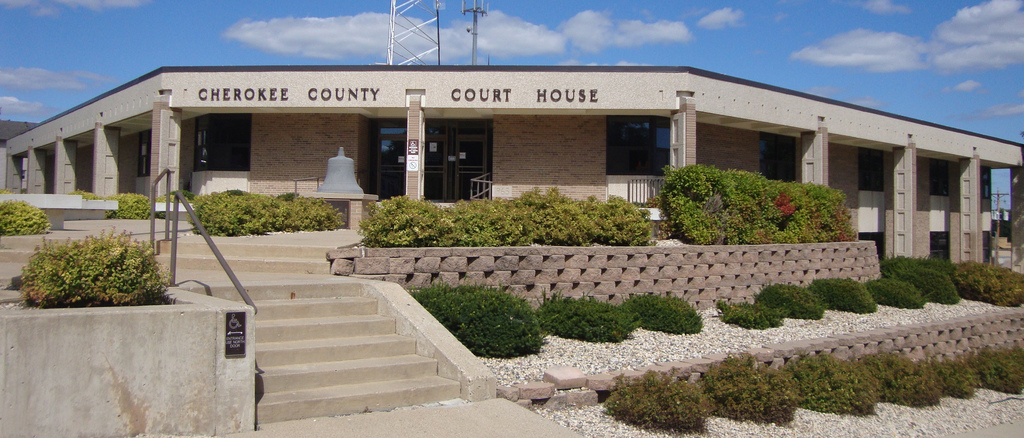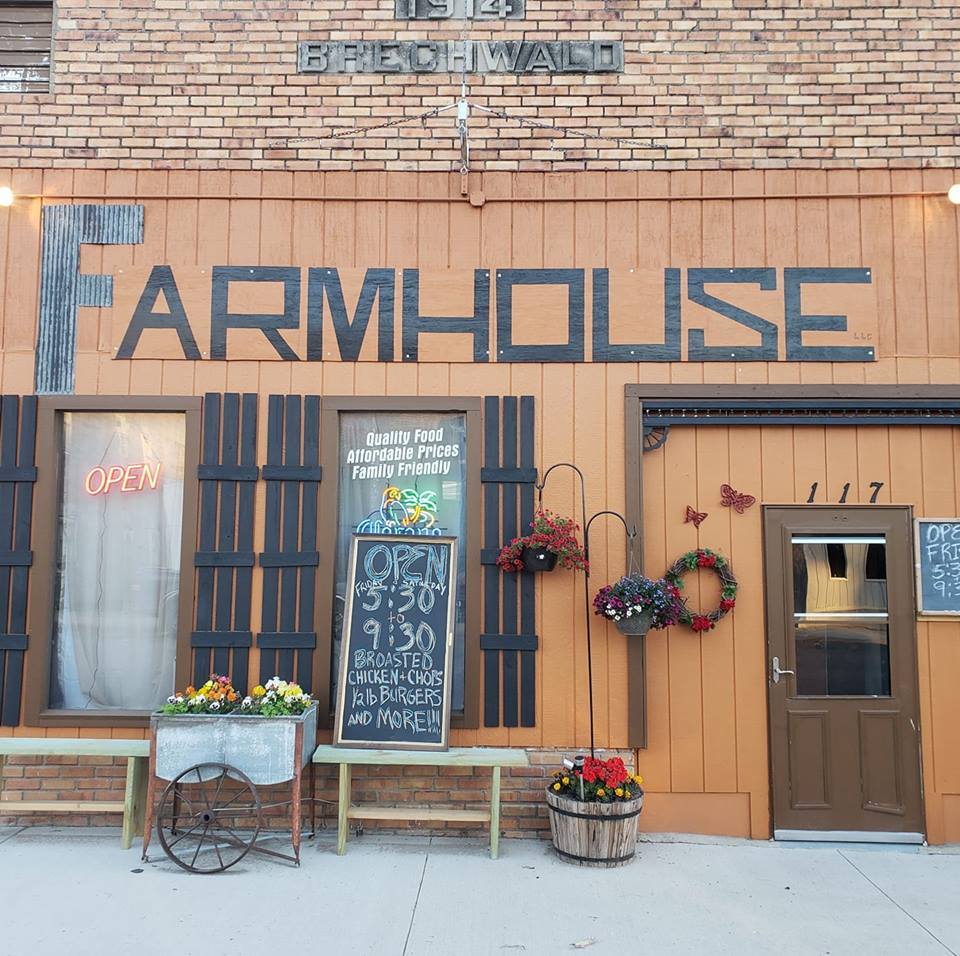Since the founding of our communities, organizations, businesses and citizens have stepped forward to build and serve their community. Click on any of the logos below to learn about those who made this website possible! If you would like to learn about becoming a sponsor CLICK HERE!
Cherokee County, IA
County in Northern IAThe first town called Cherokee, later known as "Old Cherokee", was founded in December 1857 just north of the present county seat on the west side of the Little Sioux River. The first winter was cold and food was scarce. Roving Indians visited the cabins and were amazed at the number of whites who had invaded their hunting grounds. They demanded food and killed some of the settlers’ livestock. As they went further north and found more people, the red men became angry. Perhaps the most colorful story of this conflict is that the Sioux Indian Chief Inkpaduta and the chain of events that led to the Spirit Lake Massacre. Inkpaduta and his band began their journey northward near Smithland, Iowa in the winter of 1857. This renegade band of Indians destroyed settlementsall along the Little Sioux River, including the Abbie Gardner Sharp cabin on
Lake Okoboji were today a log cabin stands as a memorial near the site of the raid. When reports of the Spirit Lake Massacre were later received in Cherokee, many settlers deserted the village. Later a stockade enclosing a log blockhouse was erected as a protection against the hostile Sioux Indians and settlers became less fearful. An election was held in the log house on George W. Lebourvea in August 1857 to elect officers for Cherokee County. In 1861, three men were appointed by the court to locate the county seat. Cherokee was selected and taxes were voted (a six-mill levy) to build a courthouse. This original courthouse was a frame building, 30 feet square, with outside stairways to the second floor. The framework of the building, located at 7th and Main Streets, was hewn from native black walnut logs. Completed in 1864 at a cost of $1900.00 (Other sources say $2050.00), the building also served as a public hall, schoolroom, and general headquarters for all public gatherings. Before its completion, county business was transacted in the private buildings of the county officials, which was "Anything but Pleasant to both officers and constituents". During the Civil War, many county men enlisted and their families withdrew to more populated areas. After the war they came back to their land and homes. The promise of a railroad from Fort Dodge to Sioux City running through Cherokee brought many businesses and professional people during the late 1860’s. The railroad was finally completed in 1870. It did not cross the Little Sioux where expected, although speculators had built up quite a town near the bridge built by the early colonists. In the spring of 1870, these folks moved about a mile and a half to the new depot the railroad had set up, dragging houses, shops, and their county courthouse with them. There were not over ten houses in “New Cherokee” prior to that time. New Cherokee grew very fast and soon had many stores and a newspaper, The Times, which celebrated its Centennial in 1970. Cherokee had a Centennial Celebration in 1956 honoring all of the pioneers.
In 1873 Cherokee became an incorporated town. Another railroad was secured in 1887 connecting Cherokee with Sioux Falls, South Dakota, to the north. A later line connected several towns to the south. In 1894, the Legislature selected Cherokee as the site for the new Mental health Hospital (Now the Mental Health Institute). Although a new courthouse was thought necessary as early as 1889, proposals to build a new courthouse at Cherokee were rejected at elections held in 1881. It was not until 10 years later that the vote was favorable and the building was erected. This large and impressive courthouse was constructed of pressed brick, limestone, granite and slate. An imposing position on a hill overlooking the business section of the city was selected as the site for the 63 x 93' Building. Of the Romanesque style of architecture, with clock tower, it cost the county at $40.000.00. The original courthouse building was eventually torn down the winter of 1936-37.
In time, the courthouse completed in 1892, also reached a state of deterioration and after turning down bond issues for a new courthouse at two previous elections (June 6, 1960 and October 1963) 61.5% of the voters (4,574 yes and 2,892 no) finally gave approval for a $575,000.00 bond issue to replace the nearly three-quarters-of-a-century old building on November 3, 1964.
The 1892 Courthouse was torn down early in 1965 (at a cost of $7,690.00) and construction began on the new building, located on the same site. The general contract was awarded to Paul Park Company, Storm Lake, for $356,442.00. The total construction cost was $560,670.00. The new courthouse dedicated October 16, 1966, is a modern, split-level design.

- County: Cherokee County, IA
- Region: Northern IA
Destination Cherokee County, IA
- Sponsors
- Towns
- Businesses
- Community Organizations
- Faith Organizations
- Festivals and Events
- Points of Interest
- Veterans
Learn how to contribute to any of the above categories.
Towns of Cherokee County, IA
The small towns of the Midwest are rich in history and a great way of life! Below you can visit and learn about the small towns we call home! Towns that have their name highlighted have become FEATURED TOWNS. Businesses/organizations from these towns have stepped forward as SPONSORS enabling us to include (or will include as acquired) stories and website links to ALL their community organizations (chambers, groups and departments, etc.), stories and website links to ALL their points of interest, annual festivals/events and stories done about their citizens, veterans and faith community. To learn how to become a featured town CLICK HERE!
Businesses of Cherokee County, IA
The businesses of our towns are truly the lifeblood of each community, click on any businesses below to learn about them, to learn how to add your business to your town and county page CLICK HERE!
Community Organizations of Cherokee County, IA
Small towns and rural communities throughout the Midwest are looking for ways to strengthen their economies, provide better quality of life, and build on local assets. Here you will find the organizations that stabilize, preserve, and revitalize the small towns and rural areas alike. To submit your organization to be included on your town and county page CLICK HERE!
Events of Cherokee County, IA
The small towns of the Midwest have long shared pride in their communities through festivals and events! Citizens from each community, working together, continue to offer entertainment options that not only appeal to their citizens, but visitors to their community! Below you will find festivals and events you are sure to want to attend! If you would like to have (DST) include an annual festival or event on your town and county page CLICK HERE!
Faith Organizations of Cherokee County, IA
Throughout the years faith organizations have not only been an essential part of a town's religious life, but its community life. Below you will find stories about these organizations, If you would like to induct a faith organization to be added to your town and county page CLICK HERE!
Points of Interest of Cherokee County, IA
The communities of the Midwest have a lifestyle unique to their region — rich in history and points of interest like no other! Below you will find points of interest you are sure to want to visit! To nominate a landmark, historic location, museum, etc. as a point of interest on your county and region page CLICK HERE!
Veterans of Cherokee County, IA
Veterans come from many walks of life and whether a veteran has severed two decades ago or two days ago, they have made our freedoms possible. Below you will find stories about many who have served. If you would like to nominate a veteran to be included on your town and county page CLICK HERE!


























































































